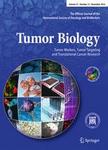版权所有:内蒙古大学图书馆 技术提供:维普资讯• 智图
内蒙古自治区呼和浩特市赛罕区大学西街235号 邮编: 010021

作者机构:Univ Navarra CIFA Unidad Biol Tumores Cerebrales Pamplona 31008 Spain Univ Navarra Sch Sci Brain Tumor Biol Unit Pamplona 31008 Spain La Paz Univ Hosp Res Unit Madrid Spain
出 版 物:《TUMOR BIOLOGY》 (肿瘤生物学)
年 卷 期:2010年第31卷第5期
页 面:381-390页
核心收录:
学科分类:1002[医学-临床医学] 100214[医学-肿瘤学] 10[医学]
基 金:Asociacion de Amigos de la Universidad de Navarra Departamento de Educacion del Gobierno de Navarra Departmento de Salud del Gobierno de Navarra [9/07] Caja Navarra [08/13912] Fundacion Universitaria de Navarra, Pamplona and Fondo de Investigacion Sanitaria, Madrid [PI081849]
主 题:Sonic hedgehog Cyclopamine CD133 Medulloblastoma PNET EWS/FLI1
摘 要:CD133 has recently been used as a reliable marker for brain tumor stem cells isolation. Sonic hedgehog (SHH) is implicated in medulloblastoma and central primitive neuroectodermal tumor (cPNET) formation. It has recently been suggested a role for the EWS/FLI1 fusion protein-typical of pPNET-in the upregulation of GLI1 and PTCH1 genes. Cyclopamine inhibits the SHH pathway in medulloblastoma cell lines, but its effect on cPNET and pPNET cell lines has not been well established yet. Our purpose was to study the effect of cyclopamine on medulloblastoma and PNET cell lines and to analyze whether CD133 expression might be able to modify this effect. We analyzed gene expression, cell viability, apoptosis, and tumorigenic capability before and after cyclopamine treatment in CD133 high-expressing and CD133 low-expressing cell lines. All medulloblastoma and PNET cell lines displayed an inhibitory effect on the expression of SHH pathway genes, on viability, and on tumorigenic potential after treatment. Nevertheless, CD133 expression made the cells more resistant to cyclopamine inhibition. These results open new doors to the understanding of CD133+ cancer stem cells as residual cells that might be responsible for treatment resistance.